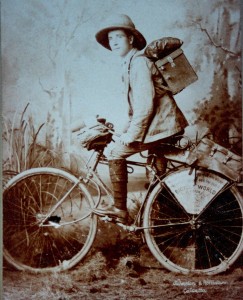By David Herlihy (Guest Contributor)
The basic bicycle, or “velocipede,” debuted in Paris during the Universal  Exhibition of 1867. “A Revolution in Locomotion,” effused the New York Times correspondent, adding that the slender vehicle could fly through the air at speeds approaching twelve miles an hour. An industry quickly sprung up in Paris with its own organ, Le Vélocipède Illustré.
Exhibition of 1867. “A Revolution in Locomotion,” effused the New York Times correspondent, adding that the slender vehicle could fly through the air at speeds approaching twelve miles an hour. An industry quickly sprung up in Paris with its own organ, Le Vélocipède Illustré.
Despite its crude construction, consisting of an 80-pound solid iron frame mounted on wooden carriage wheels with no tires, hopes ran high that the bicycle would soon serve as the “poor man’s horse.” Le Vélocipède Illustré. ran a serial entitled “Around the world on a Velocipede,” starring a fictitious American tourist named Jonathan Schopp.
Of course, not everyone shared such a rosy prognosis. Even the highly imaginative Jules Verne seems to have discounted the far-fetched notion that the bicycle would ever prove practical. In his equally fictitious Around the World in Eighty Days (first published in 1873), the protagonist Phileas Fogg makes use of numerous state-of-the-art vehicles and vessels, but pointedly no velocipedes.
Still, time would eventually vindicate the original champions of cycling. In the 1870s, the vehicle gradually evolved into an impressive road-worthy vehicle, shedding half its weight thanks to numerous improvements such as steel tubing and smooth ball bearings, while assuming the daunting but effective profile connoted by “penny farthing.”
At last, in 1884, a young English-born American named Thomas Stevens set off from San Francisco, mounted on a Columbia high wheeler. Three years later he would make his triumphant return, having covered almost 15,000 miles overland while cycling in three continents. He would be the inspiration for Frank Lenz, who set off nearly a decade later on a new-fangled “safety” bicycle (the modern prototype) determined to become the most famous and remarkable of all the “globe girdlers.” In a sense, he would succeed.
 David V. Herlihy is the author of The Lost Cyclist (Houghton Mifflin Harcourt, 2010) and Bicycle: The History (Yale University Press), winner of the 2004 Award for Excellence in the History of Science. A recognized authority in his field, he is responsible for the naming of a bicycle path in Boston after Pierre Lallement, the original bicycle patentee, and for the installation of a plaque by the New Haven green where the Frenchman introduced Americans to the art of cycling in 1866.
David V. Herlihy is the author of The Lost Cyclist (Houghton Mifflin Harcourt, 2010) and Bicycle: The History (Yale University Press), winner of the 2004 Award for Excellence in the History of Science. A recognized authority in his field, he is responsible for the naming of a bicycle path in Boston after Pierre Lallement, the original bicycle patentee, and for the installation of a plaque by the New Haven green where the Frenchman introduced Americans to the art of cycling in 1866.
This post was originally published on Wonders & Marvels in August 2010.
